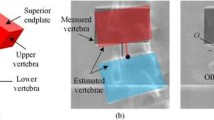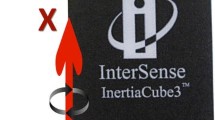Abstract
The purposes of this study were to determine the influence of kinematic model parameter variability on scapulothoracic angle estimates, and to define which parameters of the kinematic model have the largest effect on scapulothoracic angle estimates. Nominal subject-specific kinematic models of nine participants were implemented. Fifteen parameters of the nominal models relative to the clavicle length, ellipsoid, sternoclavicular and acromioclavicular joint centers, and contact point location were altered from − 1 to 1 cm. Then, scapulothoracic angles were computed during four movements using multibody kinematic optimizations for nominal and altered models. The percentage of scapulothoracic angle variance explained by each parameter of the kinematic model was computed using Effective Algorithm for Computing Global Sensitivity Indices. When altering simultaneously the 15 parameters of the kinematic model, scapulothoracic angles varied up to 50°. For all movements and degrees of freedom, the clavicle length significantly explained the largest part of scapulothoracic angle variance (up to 25%, p < 0.01). In conclusion, kinematic model parameters need to be estimated accurately to avoid any bias in scapulothoracic angle estimates especially in a clinical context. The present sensitivity analysis may also be used as a benchmark for future works focusing on improving shoulder kinematic models.
Graphical abstract
The curves represent mean scapulothoracic angles computed with the nominal model and their variability when kinematic model parameters are altered. The colormap graphs represent the percentage of scapulothoracic angle variance explained by each parameter of the kinematic model.









Similar content being viewed by others
References
Kibler WB, Ludewig PM, McClure PW, Michener LA, Bak K, Sciascia AD (2013) Clinical implications of scapular dyskinesis in shoulder injury: the 2013 consensus statement from the ‘Scapular Summit.’ Br J Sports Med 47:877–885. https://doi.org/10.1136/bjsports-2013-092425
Kibler WB, Sciascia A, Wilkes T (2012) Scapular dyskinesis and its relation to shoulder injury. J Am Acad Orthop Surg 20:364–372. https://doi.org/10.5435/JAAOS-20-06-364
Carbone S, Moroder P, Runer A, Resch H, Gumina S, Hertel R (2016) Scapular dyskinesis after Latarjet procedure. J Shoulder Elbow Surg 25:422–427. https://doi.org/10.1016/j.jse.2015.08.001
Begon M, Andersen MS, Dumas R (2018) Multibody kinematics optimization for the estimation of upper and lower limb human joint kinematics: a systematized methodological review. J Biomech Eng 140. https://doi.org/10.1115/1.4038741
Duprey S, Naaim A, Moissenet F, Begon M, Cheze L (2017) Kinematic models of the upper limb joints for multibody kinematics optimisation: an overview. J Biomech 62:87–94. https://doi.org/10.1016/j.jbiomech.2016.12.005
Seth A, Matias R, Veloso AP, Delp SL (2016) A biomechanical model of the scapulothoracic joint to accurately capture scapular kinematics during shoulder movements. PLoS ONE 11:e0141028. https://doi.org/10.1371/journal.pone.0141028
Prinold JA, Bull AM (2014) Scaling and kinematics optimisation of the scapula and thorax in upper limb musculoskeletal models. J Biomech 47:2813–2819. https://doi.org/10.1016/j.jbiomech.2014.05.015
Michaud B, Duprey S, Begon M (2017) Scapular kinematic reconstruction – segmental optimization, multibody optimization with openloop or closed-loop chains: which one should be preferred? Int Biomech 4:86–94. https://doi.org/10.1080/23335432.2017.1405741
Michaud B, Jackson M, Arndt A, Lundberg A, Begon M (2016) Determining in vivo sternoclavicular, acromioclavicular and glenohumeral joint centre locations from skin markers, CT-scans and intracortical pins: a comparison study. Med Eng Phys 38:290–296. https://doi.org/10.1016/j.medengphy.2015.12.004
Charbonnier C, Chague S, Kolo FC, Chow JC, Ladermann A (2014) A patient-specific measurement technique to model shoulder joint kinematics. Orthop Traumatol Surg Res 100:715–719. https://doi.org/10.1016/j.otsr.2014.06.015
Dumas R, Duprey S (2022) Subject-specific model-derived kinematics of the shoulder based on skin markers during arm abduction up to 180° - assessment of 4 gleno-humeral joint models. J Biomech 136:111061. https://doi.org/10.1016/j.jbiomech.2022.111061
Hybois S, Lombart A, Puchaud P, Bascou J, Lavaste F, Pillet H et al (2017) Effects of ellipsoid parameters on scapula motion during manual wheelchair propulsion based on multibody kinematics optimization. A preliminary study. Comput Methods Biomech Biomed Engin 20:107–108. https://doi.org/10.1080/10255842.2017.1382884
El Habachi A, Duprey S, Cheze L, Dumas R (2013) Global sensitivity analysis of the kinematics obtained with a multi-body optimisation using a parallel mechanism of the shoulder. Comput Methods Biomech Biomed Engin 16(Suppl 1):61–62. https://doi.org/10.1080/10255842.2013.815907
Ludewig PM, Phadke V, Braman JP, Hassett DR, Cieminski CJ, LaPrade RF (2009) Motion of the shoulder complex during multiplanar humeral elevation. J Bone Joint Surg Am 91:378–389. https://doi.org/10.2106/JBJS.G.01483
Wu G, van der Helm FC, Veeger HE, Makhsous M, Van Roy P, Anglin C et al (2005) ISB recommendation on definitions of joint coordinate systems of various joints for the reporting of human joint motion–part II: shoulder, elbow, wrist and hand. J Biomech 38:981–992. https://doi.org/10.1016/j.jbiomech.2004.05.042
Blache Y, Degot M, Rogowski I (2022) Does scapulothoracic contact point trajectory follow an ellipsoid surface? Comput Methods Biomech Biomed Engin 24:sup1, S1-S325. https://doi.org/10.1080/10255842.2021.1978758
Pianosi F, Beven K, Freer J, Hall JW, Rougier J, Stephenson DB et al (2016) Sensitivity analysis of environmental models: a systematic review with practical workflow. Environ Model Softw 79:214–232. https://doi.org/10.1016/j.envsoft.2016.02.008
Plischke E (2010) An effective algorithm for computing global sensitivity indices (EASI). Reliab Eng Syst Saf 95:354–360. https://doi.org/10.1016/j.ress.2009.11.005
Pataky TC (2010) Generalized n-dimensional biomechanical field analysis using statistical parametric mapping. J Biomech 43:1976–1982. https://doi.org/10.1016/j.jbiomech.2010.03.008
Hillen RJ, Burger BJ, Poll RG, van Dijk CN, Veeger DH (2012) The effect of experimental shortening of the clavicle on shoulder kinematics. Clin Biomech 27:777–781. https://doi.org/10.1016/j.clinbiomech.2012.05.003
Su WR, Chen WL, Chen RH, Hong CK, Jou IM, Lin CL (2016) Evaluation of three-dimensional scapular kinematics and shoulder function in patients with short malunion of clavicle fractures. J Orthop Sci 21:739–744. https://doi.org/10.1016/j.jos.2016.07.005
Thorsmark Hoj A, Villa C, Christensen OM, Torp-Pedersen S, Overgaard S, Frich LH (2017) Validation of navigation ultrasound for clavicular length measurement. Ultrasound Med Biol 43:1722–1728. https://doi.org/10.1016/j.ultrasmedbio.2017.04.005
Smekal V, Deml C, Irenberger A, Niederwanger C, Lutz M, Blauth M et al (2008) Length determination in midshaft clavicle fractures: validation of measurement. J Orthop Trauma 22:458–462
Stegeman SA, de Witte PB, Boonstra S, de Groot JH, Nagels J, Krijnen P et al (2016) Measurement of clavicular length and shortening after a midshaft clavicular fracture: spatial digitization versus planar roentgen photogrammetry. J Electromyogr Kinesiol 29:74–80. https://doi.org/10.1016/j.jelekin.2015.07.007
Nicholson KF, Richardson RT, Miller F, Richards JG (2017) Determining 3D scapular orientation with scapula models and biplane 2D images. Med Eng Phys 41:103–108. https://doi.org/10.1016/j.medengphy.2017.01.012
Bolsterlee B, Veeger HE, van der Helm FC (2014) Modelling clavicular and scapular kinematics: from measurement to simulation. Med Biol Eng Comput 52:283–291. https://doi.org/10.1007/s11517-013-1065-2
Reinbolt JA, Schutte JF, Fregly BJ, Koh BI, Haftka RT, George AD et al (2005) Determination of patient-specific multi-joint kinematic models through two-level optimization. J Biomech 38:621–626. https://doi.org/10.1016/j.jbiomech.2004.03.031
Andersen MS, Damsgaard M, MacWilliams B, Rasmussen J (2010) A computationally efficient optimisation-based method for parameter identification of kinematically determinate and over-determinate biomechanical systems. Comput Methods Biomech Biomed Engin 13:171–183. https://doi.org/10.1080/10255840903067080
Jacquelin E, Brizard D, Dumas R (2019) A screening method to analyse the sensitivity of a lower limb multibody kinematic model. Comput Methods Biomech Biomed Engin 22:925–935. https://doi.org/10.1080/10255842.2019.1604950
Author information
Authors and Affiliations
Corresponding author
Ethics declarations
Informed consent
This research involved human participants who signed an informed consent after the study was approved by the local ethical committee.
Conflict of interest
The authors declare no competing interests.
Additional information
Publisher's note
Springer Nature remains neutral with regard to jurisdictional claims in published maps and institutional affiliations.
Supplementary Information
Below is the link to the electronic supplementary material.
Rights and permissions
About this article
Cite this article
Blache, Y., Rogowski, I., Degot, M. et al. Uncertainty analysis and sensitivity of scapulothoracic joint angles to kinematic model parameters. Med Biol Eng Comput 60, 2065–2075 (2022). https://doi.org/10.1007/s11517-022-02593-1
Received:
Accepted:
Published:
Issue Date:
DOI: https://doi.org/10.1007/s11517-022-02593-1




